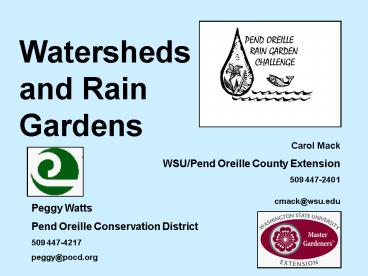Winter Salad Gardening - PowerPoint PPT Presentation
1 / 74
Title: Winter Salad Gardening
1
Watersheds and Rain Gardens
Carol Mack WSU/Pend Oreille County Extension 509
447-2401 cmack_at_wsu.edu
Peggy Watts Pend Oreille Conservation
District 509 447-4217 peggy_at_pocd.org
2
What is a Rain Garden?
... A depression that is situated so that it
collects more than its share of rainfall
3
Natural Rain Gardens
4
www.raingardens.org
5
Why Build a Rain Garden?
- Cleaner water, better fish habitat
- More rainwater percolating into ground instead of
joining surface runoff
6
Why Build a Rain Garden?
Harvesting rain to create a small ecosystem for
water-loving plants
7
Why Build a Rain Garden?
Because of the wildlife it supports!
8
Why Build a Rain Garden? --Bank Stabilization
- Divert and absorb runoff before it reaches the
bank and increases erosion
9
Rain Water Harvesting--Two sources
1. Impervious surfaces like roof or road
2. Lawn or fields (especially near streams,
rivers and lakes.)
10
Riparian Rain Garden at base of mowed
lawn captures sheet run-off
11
Any size or shape...
12
Wisconsin rain garden
13
(No Transcript)
14
Portland
15
Seattle
16
Naturalized landscapes
17
Bellingham
18
Spokane Swale Demonstration Project http//www.spo
kane-county.wsu.edu/spokane
19
Bio-swales Retention Ponds But with
plants!
20
A smaller rain garden in a riparian
areahttp//www.dnr.state.wi.us/org/water/wm/nps/r
g/littleone/
21
(No Transcript)
22
Screened outlet
23
Plants added
24
Mature garden
25
(No Transcript)
26
Deer Valley area rain garden --BEFORE
27
Deer Valley area rain garden --BEFORE
28
During construction
29
Just planted
30
Choosing a Spot
- Below water source
- View
- Where water can infiltrate within several days
(mosquitoes!) - Above areas where water already gathers
31
- Downhill of house
- Place at least 10 feet from foundation
- Avoid septic system drainfield
- Avoid utility lines and rights-of-ways
- Dont place under large trees
- Dont dig depression above eroding bank
32
Evaluate the Soil--Will it drain?
- Sandy soil
- just add compost
- Clay replace with
- 50-60 sand
- 20-30 topsoil
- 20-30 compost.
Soil texture--mix of sand, loam and clay
33
Test the Drainage 8x8x8 hole-- water level
should go down at least 1 inch per hour
34
- Doesnt Drain?
- Make it shallower to retain less water
- Make it larger
- Replace clay with topsoil/compost mix
- Add a drain system to transport extra water away
35
Compacted soil? --Dig and loosen two
feet deep
36
Garden design
37
- Grade the soil
- Think saucer, not bowl
- Generally 6 inches deep
38
Break water flow with rocks
39
Finish with layer of mulch
- Conserves water
- Decreases weeding
- Absorbs nutrients
40
Weed if needed
41
Water first year to get established
In our climate, some plants may need dry-season
watering.
42
Gardeners--we need you!
43
(No Transcript)
44
(No Transcript)
45
Mostly Natives-Because they-Survive the dry
period-Provide
food for wildlife
Choosing Plants
46
Where to get Plants?
- Master Gardener Plant Sale
- Conservation District Plant Sale
- Native Plant nurseries
- Salvage from wild
- Propagate from seeds or cuttings
47
Some Native Rain Garden Plants...
- Trees
- Shrubs
- Ground covers
48
Bitter Cherry, Chokecherry
49
Rocky Mountain Maple
50
Scoulers willow (dryer sites)
51
Riparian Willow Varieties
52
Quaking aspen
53
Cascara
54
Yew and Hemlock
55
Red-osier Dogwood
56
Baldhip rose, Nootka rose
57
Blue Elderberry, Redstem Ceonothus
58
Mallow ninebark, snowberry
59
Viburnum (highbush cranberry)
Serviceberry
60
Tall Oregon Grape, Thimbleberry
61
Pink Spirea (hardhack), Oceanspray
62
Bracken Fern, Lady Fern, Sword Fern
63
Oak Fern, Maidenhair Fern
64
Goatsbeard (Aruncus)Solomons plume
65
Star-flowered False Solomon's Seal,
Trillium
66
Wild Ginger, Wild Strawberry
67
Yellow monkeyflower,
Western columbine
68
Twinflower, Bunchberry dogwood
69
Thick-headed sedge, Deweys sedge
70
Idaho fescue, Orange
honeysuckle
71
Pacific waterleaf, Pearly
everlasting
72
Blue camas
73
Rain Gardens--Where to Next?
74
Thank you!
- Carol Mack
- cmack_at_wsu.edu































